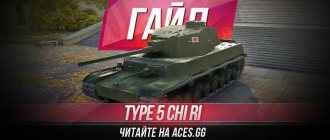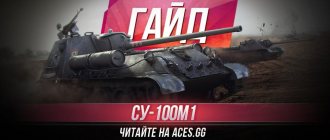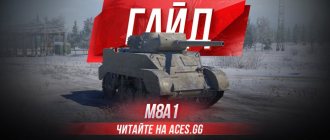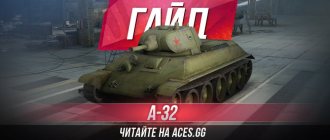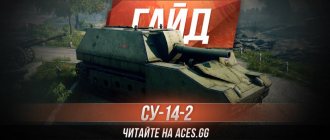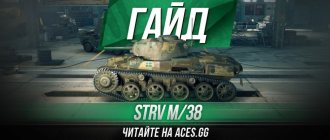Hello, tank men and women, aces.gg is here! Today on our agenda is the brainchild of German tank engineers, we are talking about Art-SPG of the sixth level and now in front of you is a Hummel guide
.
At its level, this unit poses a truly serious danger to most other machines. However, in order to realize the potential of this artillery, you need to know the performance characteristics of Hummel World of Tanks
, understand the main advantages and disadvantages of the machine, be able to equip it correctly, etc.
TTX Hummel
As befits any self-propelled artillery unit in our game, this German has a small margin of safety (the best among self-propelled guns-6), as well as a very poor initial visibility with a radius of 265 meters.
In terms of security, in our case everything is very mediocre, or more precisely, Hummel has the characteristics
no reservations at all. The strongest place is the frontal projection of the hull, where the thickness of the armor varies from 32 to 49 mm. Of course, such cardboard makes its way to everyone, but there’s nothing to even talk about other projections and “paper” open cabins.
But there are glimmers of light in this kingdom of darkness, which lies in the fact that the German tank Hummel WoT
has small dimensions. For this reason, the camouflage at our disposal is good, it is difficult to detect this art, and besides, the stealth coefficient can and should be increased.
But let's come back to earth again, since the driving performance of this self-propelled gun is very far from perfect. Art self-propelled gun Hummel World of Tanks
got a good maximum speed, but the dynamics and, moreover, the maneuverability are weak here, that is, the car is at least a bit stiff in terms of mobility.
Technical characteristics of the Hummel self-propelled guns in the game.
| Characteristics/Tank | Hummel | SU-8 | M-41 |
| Strength | 320 | 310 | 300 |
| Weight (t) | 24,69/25,3 | 20,62/20,8 | 18,79/19,2 |
| Engine power (hp) | 585 | 440 | 240 |
| Maximum speed (km/h) | 40 | 33 | 56 |
| Turning speed (deg/sec) | 48 | 18 | 18 |
| Hull armor (front/sides/stern in mm) | 30/10/10 | 20/20/18 | 13/13/13 |
| Basic projectile damage | 713-1188 | 349-581 | 525-875 |
| Armor penetration with basic projectile (mm) | 64-106 | 49-81 | 59-98 |
| Gun rate (rounds/min) | 3,24 | 5,50 | 4 |
| Horizontal guidance speed (deg/sec) | 25 | 14 | 18 |
| Review (m) | 450 | 440 | 450 |
| Communication range (m) | 810 | 410 | 370 |
As we can see from the characteristics table, Hummel is the most powerful in its class. Despite the low rate of fire, it has the most powerful weapon, which deals sufficient damage and has good armor penetration. Hummel can penetrate any level of tank, even Maus. Hummel always shows better statistics than other art of its class. The gun hits quite accurately, as for art, for example, I have a hit percentage of 34% according to statistics, for art, in my opinion, it’s pretty good, the same CT that I have in the hangar has an indicator of 79%. The advantages of this self-propelled gun also include good speed and maneuverability, which plays a positive role when we play in tank mode, for example, on city maps. In general, very positive impressions from playing on this vehicle, when you are tired of constantly fidgeting with the mouse, turning the tank’s turret, change to the Hummel and give your hands a break.
gun
From all of the above, it is clear that our overall performance characteristics are frankly weak, but this is artillery in front of you and its whole essence lies in the armament, and looking ahead, I will say that the gun is worthy of respect.
First of all, you should know that the Hummel has a gun
has a really powerful alpha strike for its level. Subject to a successful hit, we have the opportunity to send most of the seventh level tanks to the hangar, and the rate of fire at our disposal is quite good, which cannot be said about subsequent German self-propelled guns.
Regarding the penetration parameters, everything is still very worthy, Hummel art
is capable of confidently inflicting damage, but if it hits a heavy tank, especially in some hard place, you shouldn’t expect big numbers.
Hummel World of Tanks shoots
only with high-explosive shells, which have a 7-meter radius of scattering fragments, which is not very much, but after the release of update 0.9.18 we now have the opportunity to stun enemy vehicles that fall under our splash, which not only causes damage, but also temporarily reduces the parameters of affected tanks.
The last thing you should know when playing the Hummel WoT SAU
– comfort of dealing damage. Of course, it takes a really long time for our gun to be aligned, but our spread is good compared to some of our classmates.
However, even more pleasing are the horizontal aiming angles, which in total amount to as much as 30 degrees. Thanks to this indicator, the Hummel tank is able to easily fire in a wide sector, spending less time on re-alignment.
Design and production of Hummel and Wespe
Research has shown that the chassis of the German Pz.Kpfw tanks is most suitable for mounting on them the 105 mm lFH 18 gun and the 150 mm sFH 18 gun. II and Pz.Kpfw. IV. The main alteration of the chassis consisted of moving the engine compartment from the stern to the middle part, the fighting compartment was equipped in the rear of the vehicle.
The armoring of the selected chassis remains unchanged; the wheelhouse armoring must provide protection for the crew from small arms bullets, primarily machine guns, and from shrapnel.
The stability of the platform under the gun should ensure maximum stability of the self-propelled gun at any position of the gun. It is necessary to ensure that as much ammunition as possible can be carried inside the vehicle; the fuel supply does not need to be changed compared to the base tanks.
It was assumed that the crew of the self-propelled gun armed with the 105-mm lFH 18 (“Wespe”) cannon would be 6 people, the self-propelled gun armed with the 150-mm sFH 18 (“Hummel”) gun would be 7 people.
All necessary new components, assemblies and structural parts of new machines must be manufactured strictly using existing equipment using existing technological processes, and operations requiring mechanical processing should be kept to a minimum.
Both Hummel and Vespa immediately ran into the limitations of their chosen development scheme. The most important disadvantage of using a chassis designed for a completely different type of vehicle was quite expected and well known from the early versions of “self-propelled gun conversions”. They had very limited transportable ammunition for self-propelled guns - on the same Hummel it was only 18 rounds, as a result, approximately 22-24% of all new self-propelled guns had to be built in the ammunition transporter version. The design of the transporters was practically no different from the design of the self-propelled guns. It was possible to install guns on conveyors in the field.
The arrival of both light and heavy self-propelled guns of new types into combat units began in the spring of 1943.
Doubts about the effectiveness of the “interim solution” were dispelled after the successful use of self-propelled guns as part of artillery batteries of tank divisions. The panzer divisions now received excellent artillery cover. The worsening military situation in Germany led to the abandonment of plans for further work on the “final solution”; work within the framework of this program was limited to the construction of several prototypes of self-propelled guns.
Advantages and disadvantages
It is quite difficult to talk about specific features in the case of artillery, since the whole point lies in the weapon, and in the opinion of many it always takes a long time to bring down and hits obliquely. However, in battle, each parameter plays an important role, and you must know the tank you are playing on. For these reasons, we will now highlight the main advantages and disadvantages of the Hummel World of Tanks Art SPG
. Pros: • Small dimensions and good camouflage; • Decent accuracy; • Powerful alpha strike; • Good penetration; • Very comfortable UGN. Cons: • Small margin of safety and visibility; • Weak armor; • Mediocre mobility; • Long mixing.
Historical information on the Hummel self-propelled guns.
Some historical information on Shmel, and this is how the word is translated from German - Hummel. In 1941-42 The engineers of the German military complex were tasked with creating a fast and mobile self-propelled gun with a powerful cannon. As a result, Alkett developed the Hummel assault self-propelled gun. The armament for the self-propelled guns was the 150 mm sFH 18 howitzer. Serial production of the vehicles began in 1943; over the entire production period, 724 vehicles were manufactured. The vehicle performed excellently during the entire period of use during combat operations.
Equipment for Hummel
As is usually the case, when purchasing and installing additional modules, it is important to understand what qualities of the machine need to be enhanced. In the case of artillery, maximum attention is always paid to the rate of fire and aiming, so in general the equipment on the Hummel tank
It’s worth setting this: 1. – will give you the opportunity to shoot a little more often, which is always important, because this way you can deal more damage per battle. 2. – due to the long reduction, the process of causing damage becomes somewhat more complicated, that is, this issue also needs to be addressed first. 3. – due to open logging, we don’t have any other good alternatives, so we increase our survivability by improving camouflage.
The design of the Hummel self-propelled howitzer
A prototype of a self-propelled gun with a 150-mm sFH 18 cannon on a PzKpfw tank chassis. IV, was called Geschutzwagen III/IV (developer: Alkett). The best systems of PzKpfw tanks were selected for the design of the vehicle. III/IV. The appearance of the chassis was more consistent with the chassis of the PzKpfw tank. IV Ausf.F, at the same time, the internal equipment is mostly similar to the PzKpfw tank. III Ausf. J.
A slightly modified hull and chassis with road wheels, support rollers, suspension, sloth tracks, track tensioning devices, etc. were taken from the PzKpfw IV tank.
From the PzKpfw III tank - Maybach HL-120TRM engine with SSG-77 transmission, braking devices, drive wheels, control mechanisms.
New shafts that transmit power from the engine, exhaust pipes, oil filters, inertial starters, fuel lines, and winter equipment were developed especially for the Hummel self-propelled guns.
The fighting compartment on both self-propelled guns, the Hummel and the Wespe, was located in the rear of the vehicle and was open at the top. To protect from bad weather, a tarpaulin awning could be installed above the wheelhouse.
The engine compartment is located in the middle part, the control compartment is in the front. The control compartment is isolated from the fighting compartment. Access to the control compartment was through two hatches. In addition to the cannon, the self-propelled gun was armed with an MG-34 or MG-42 machine gun; for self-defense, the crew had two MP-40 machine guns and pistols.
The vehicles were equipped with an extremely reliable Maybach HL-120TRM engine and SSG-77 transmission. The use of the transmission of the PzKpfw III tank led to the need to install brakes, turning mechanisms and drive wheels from the same tank on the self-propelled gun. At the same time, the Maybach HL-120TRM engine did not provide the self-propelled gun with the specific power specified in the requirements.
The radio equipment of the self-propelled guns is unified with the radio equipment of artillery spotter vehicles. The Hummel and Wespe self-propelled guns and Munitionstrager ammunition transporters were equipped with Funksprechgerat f (FuSprG 0 and Bordsprechgerat (BoSprG) radio stations. Usually, Panzer-Beobachtungswagen III artillery spotter vehicles, made on the basis of PzKpfw III tanks, worked together with the self-propelled guns. The radio equipment of these vehicles included radio stations Funksprechgerat f (FuSprG 0. Bordsprechgerat (BoSprG), Tornisterfunkgerat g (TornFuG g-movable), mid-frequency receivers FU-4 and FU-8, 30-watt radio transmitter operating in the medium wave range.
Drawing of a self-propelled howitzer "Hummel"
External differences of early production self-propelled guns
- sloths from the PzKpfw IV Ausf.D tank;
- exhaust pipes are laid only on one fender above the sloth;
- one spare road wheel is mounted on the frontal armor plate;
- one Bosh headlight is installed on each slat;
- the drive wheels are similar to those used on the PzKpfw III Ausf.E tanks;
- rubberized track support rollers are similar to those used on PzKpfw IV Ausf.D tanks;
- engine ventilation grilles in the right and left armor plates of the wheelhouse;
- folding slats over sloths.
External differences of early production self-propelled guns - sloths are similar to those used on PzKpfw IV Ausf.F tanks;
- exhaust pipes are laid on the fenders on both sides;
- two spare road wheels are located on the aft armor plate;
- only one Bosh headlight is installed on the left front slat;
- drive wheels are similar to those used on PzKpfw III Ausf.J tanks;
- steel track support rollers are similar to those used on PzKpfw IV Ausf.H tanks;
- engine ventilation grilles are covered with armored shields;
- folding slats were not installed over sloths
Hummel Tactics
At first glance, the process of playing artillery in our favorite game is very simple, it especially seems so when the treasured “suitcase” flies towards you, but this is only partly true. Of course, at the very beginning of the battle for Hummel tactics
implies only occupying an advantageous and at the same time safe position away from the first and even second line.
But then there are at least two scenarios for the development of events: 1. If you are familiar with the map, you know the main positions of vehicles, the most advantageous places, you can try to look for enemy art and tracers. For this purpose the German Humme tank
l must whistle to the expected place where the opponent-artilleryman is standing and wait for his shot.
If you are right, you will soon see an outgoing tracer, in the place from which it flew out and you need to shoot. If the enemy does not move after the shot, and you hit the target exactly, helping your team will be invaluable. 2. The second scenario involves aiming at the place where enemy equipment is about to leave. Everything is simpler here, if you have taken the correct position on the Hummel WoT Art-SAU
, you have a good shot and nothing interferes with the flight of the projectile, you can fire very effectively, but it is always better to close down to the end. It is in such situations that the position you take makes itself felt.
Regarding the so-called auxiliary skills, playing on the Hummel World of Tanks self-propelled gun
After each shot, you must move at least a little so that you do not suffer the sad fate described above. In addition, if the position is not chosen in the best way or if it has simply lost its relevance, during reloading time you can find a more favorable place from which to fire.
Otherwise, it's worth remembering that Hummel art
extremely vulnerable in close combat due to lack of armor. So keep an eye on the mini-map, try not to let the enemy get close to you, and if possible, choose more dangerous targets, because disabling a strong enemy is much more important than killing a low-level tank.
Hummel's profitability.
Hummel is quite profitable, it is very difficult to go into the red after a round, unless you go for a smoke while the map is loading and at that time you will be spotted at the base and destroyed. Despite the cost of the projectile at 1120 silver, almost all rounds on it are profitable. The main thing is to shoot accurately, then per round you will receive 5000 silver or more. For example, I tried to carry out one battle, managed to fire two shots, then the artillery killed me, by the way, we destroyed each other at the same time, calculating from the tracer, and so, as a result, 2105 silver was spent on repairs, 2140 for 2 shots, and victory brought 9612 silver , more than 5000 in plus.
Changes in vehicle parameters
Great Britain
Conqueror Gun Carriage
- Projectile speed HE Mk. 18 reduced by 9%.
- Projectile speed HE Mk. 19 reduced by 9%.
- The radius of scattering fragments has been reduced by 5%.
FV4005 Stage II
- The chassis turning speed has been changed from 30 to 26 degrees/s.
- The gun spread has been changed from 0.38 to 0.42 m.
- The gun aiming time has been changed from 3 to 3.7 s.
- The maximum forward speed has been changed from 35 to 32 km/h.
- The maximum reverse speed has been changed from 12 to 8 km/h.
Germany
GW Panther
- The spread of the 15 cm sFH 18 L/29.5 gun has been changed from 0.66 to 0.68 m.
- The dispersion of the 15 cm sFH 18 L/29.5 gun when rotating the barrel has been increased by 4%.
- The spread of the 15 cm sFH 43 gun has been changed from 0.62 to 0.64 m.
- The dispersion of the 15 cm sFH 43 gun when rotating the barrel has been increased by 5%.
- The reload time of the 15 cm sFH 18 L/29.5 gun has been changed from 27.2 to 28.2 s.
- The reload time of the 15 cm sFH 43 gun has been changed from 26 to 27 s.
- The radius of scattering fragments has been reduced by 5%.
Hummel
- The radius of scattering fragments has been reduced by 5%.
GW Tiger P
- The radius of scattering fragments has been reduced by 5%.
GW Tiger
- The radius of scattering fragments has been reduced by 5%.
GW E 100
- The radius of scattering fragments has been reduced by 5%.
USSR
Object 261
- Ammunition changed from 18 to 20 shells.
T-44-122
- The dispersion of the gun due to the movement of the chassis has been reduced by 18%.
- The dispersion of the gun due to rotation of the chassis has been reduced by 18%.
- The gun spread has been changed from 0.43 to 0.41 m.
- Gun dispersion when rotating the turret has been reduced by 12%.
- Aiming time changed from 3.4 to 3 s.
- The view has been changed from 370 to 380 m.
- The turret rotation speed has been changed from 48 to 42 deg/s.
- The gun declination angle has been changed from –4 to –5 degrees.
SU-14-2
- The radius of scattering fragments has been reduced by 5%.
S-51
- The radius of scattering fragments has been reduced by 5%.
SU-14-1
- The radius of scattering fragments has been reduced by 5%.
212A
- The radius of scattering fragments has been reduced by 5%.
USA
Added car:
- T78 (for testing by supertesters)
Changing equipment parameters:
M12
- The radius of scattering fragments has been reduced by 5%.
M40/M43
- The radius of scattering fragments has been reduced by 5%.
M53/M55
- The radius of scattering fragments has been reduced by 5%.
France
Added car:
- M4A1 FL 10 (for testing by supertesters)
Czechoslovakia
Added car:
- Škoda T 27 (for testing by super testers)
Sweden
Added equipment:
- UDES 14 Alt 5
- UDES 15/16
- UDES 16
Changing equipment parameters:
Emil I
- The dispersion of the gun due to the movement of the Emil Alt 1 chassis has been increased by 12%.
- The dispersion of the gun due to the movement of the Emil Alt 2 chassis has been increased by 4%.
- The dispersion of the gun due to rotation of the Emil Alt 1 chassis has been increased by 12%.
- The dispersion of the gun due to rotation of the Emil Alt 2 chassis has been increased by 4%.
- The turning speed of the Emil Alt 1 chassis has been changed from 27 to 24 deg/s.
- The turning speed of the Emil Alt 2 chassis has been changed from 30 to 26 deg/s.
- The reload time of the 10.5 cm lvkan m/42 gun has been changed from 37 to 22.7 s.
- The reload time of the 10.5 cm TK 105-9 gun has been changed from 34 to 27 s.
- The spread of the 10.5 cm lvkan m/42 gun has been changed from 0.38 to 0.39 m.
- The aiming time of the 10.5 cm lvkan m/42 gun has been changed from 3 to 3.2 s.
- The number of shells in the magazine for the 10.5 cm lvkan m/42 gun has been changed from 4 to 3.
- The number of shells in the magazine for the 10.5 cm TK 105-9 gun has been changed from 4 to 3.
- The damage caused by the slpprj m/52 B shell of the 10.5 cm TK 105-9 gun has been changed from 320 to 360 units.
- The damage caused by the slpprj m/52 shell of the 10.5 cm TK 105-9 gun has been changed from 320 to 360 units.
- The damage caused by the sgr m/52 shell of the 10.5 cm TK 105-9 gun has been changed from 420 to 460 units.
- The ammunition capacity of the 10.5 cm lvkan m/42 gun has been changed from 52 to 57 shells.
- The ammunition capacity of the 10.5 cm TK 105-9 gun has been changed from 52 to 57 shells.
Emil II
- The reload time of the 10.5 cm TK 105-9 gun has been changed from 30 to 22 s.
- The reload time of the 12 cm akan L/40 gun has been changed from 40 to 25 s.
- The rate of fire inside the magazine for the 12 cm akan L/40 gun has been increased by 11%.
- The number of shells in the magazine for the 10.5 cm TK 105-9 gun has been changed from 4 to 3.
- The number of shells in the magazine for the 12 cm akan L/40 gun has been changed from 4 to 3.
- The damage caused by the sgr m/52 shell of the 10.5 cm TK 105-9 gun has been changed from 420 to 460 units.
- The damage caused by the slpprj m/52 shell of the 10.5 cm TK 105-9 gun has been changed from 320 to 360 units.
- The damage caused by the slpprj m/52 B shell of the 10.5 cm TK 105-9 gun has been changed from 320 to 360 units.
- The damage caused by the psgr m/51 shell of the 12 cm akan L/40 gun has been changed from 400 to 440 units.
- The damage caused by the sgr m/51 shell of the 12 cm akan L/40 gun has been changed from 515 to 530 units.
- The damage caused by the slpprj m/51 shell of the 12 cm akan L/40 gun has been changed from 400 to 440 units.
- The ammunition capacity of the 10.5 cm TK 105-9 gun has been changed from 40 to 60 shells.
- The ammunition capacity of the 12 cm akan L/40 gun has been changed from 40 to 48 shells.
- AV-1195 engine power has been changed from 400 to 420 hp. With.
- AVS-1195 engine power has been changed from 520 to 550 hp. With.
Kranvagn
- The gun reload time has been changed from 33 to 21.5 s.
- Rate of fire inside the magazine increased by 9%.
- The number of shells in the magazine has been changed from 4 to 3 shells.
- The turret rotation speed has been changed from 25 to 28 deg/s.
- The damage caused by the psgr m/51 projectile has been changed from 400 to 440 units.
- The damage caused by the sgr m/51 projectile has been changed from 515 to 530 units.
- The damage caused by the slpprj m/51 projectile has been changed from 400 to 440 units.
- Ammunition changed from 40 to 48 shells.
- Engine power was changed from 700 to 810 hp. With.
Japan
Type 4 Heavy
- The armor penetration of the Common Type 0 Kai shell for the 15 cm/45 41st Year Type gun has been changed from 75 to 192 mm.
- The armor penetration of the 14 cm Capped Common Semi-AP Kai shell for the 14 cm/50 3rd Year Type gun has been changed from 282 to 290 mm.
- The armor penetration of the 14 cm Capped Common Semi-AP shell for the 14 cm/50 3rd Year Type gun has been changed from 249 to 252 mm.
- The damage caused by the Common Type 0 Kai shell of the 15 cm/45 41st Year Type gun has been changed from 1400 to 900 units.
- The damage caused by the Common Type 0 shell of the 15 cm/45 41st Year Type gun has been changed from 1100 to 900 units.
- The order of the 14 cm/50 3rd Year Type and 15 cm/45 41st Year Type guns has been changed in the study.
- The cost of the 15 cm/45 41st Year Type gun has been changed from 332,000 to 330,000.
- The cost of the 14 cm/50 3rd Year Type gun has been changed from 330,000 to 332,000.
Type 5 Heavy
- The dispersion of the gun due to the movement of the chassis has been reduced by 11%.
- The dispersion of the gun due to rotation of the chassis has been reduced by 20%.
- The chassis turning speed has been changed from 17 to 20 degrees/s.
- The armor penetration of the 14 cm Capped Common Semi-AP shell for the 14 cm/50 3rd Year Type gun has been changed from 249 to 252 mm.
- The armor penetration of the 14 cm Capped Common Semi-AP Kai shell for the 14 cm/50 3rd Year Type gun has been changed from 282 to 290 mm.
- The armor penetration of the Common Type 0 Kai shell for the 15 cm/45 41st Year Type gun has been changed from 75 to 192 mm.
- The damage caused by the Common Type 0 Kai shell of the 15 cm/45 41st Year Type gun has been changed from 1400 to 900 units.
- The damage caused by the Common Type 0 shell of the 15 cm/45 41st Year Type gun has been changed from 1100 to 900 units.
- The maximum reverse speed has been changed from 11 to 15 km/h.
- The order of the 14 cm/50 3rd Year Type and 15 cm/45 41st Year Type guns has been changed in the study.
- The cost of the 14 cm/50 3rd Year Type gun has been changed from 330,000 to 332,000.
- The cost of the 15 cm/45 41st Year Type gun has been changed from 332,000 to 330,000.
Rebalance of Swedish heavy tanks
With the advent of a new branch of Swedish medium tanks, we want to reconsider the characteristics of the high-level heavy tanks of this nation:
- Emil I (VIII level);
- Emil II (level IX);
- Kranvagn (X level).
All these tanks now have an automatic loader for four rounds. We plan to re-equip them with three-shell automatic loaders and thus reimagine the gaming experience on these machines. Now these will be “fast drummers” with high one-time damage and an emphasis on melee combat. As a result of the changes, the damage per minute inflicted by Kranvagn will be able to increase to 3000 units.
Emil I
The vehicle received an updated loading magazine with a focus on increased one-time damage of projectiles and faster reloading between them. This change makes the gameplay of "Emil" individual and different from other "drum" tanks. His element is short-range fights with periodic magazine discharge. An increase in ammunition also contributes to this. For the new “fast” drum, you will have to part with one projectile and get used to changes in aiming and stabilization parameters and slightly reduced maneuverability.
Emil II
The older "Emil" receives weapon modifications similar to its predecessor. Increased one-time damage of shells, reduced reload time, minus one shell in the magazine and expanded ammunition capacity. In addition to increased firepower, it will receive an increase in engine power density. And, accordingly, improved driving characteristics.
Kranvagn
The Kranvagn, as a top-end vehicle, will be the pinnacle of the updated branch: a fast-reloading magazine, three shells with a single damage of 440 units each, and improved aiming time will significantly increase combat effectiveness. Damage per minute will reach almost 3000 units! The vehicle's driving performance and turret traverse speed will also improve.
Technical characteristics are indicated for machines in the maximum configuration.
Self-propelled gun rebalance
During the general test of update 1.5, we plan to revise the following values for self-propelled guns:
minimum duration of stun;
duration of stun from artillery hits on vehicles already under the influence of stun;
duration of stun when a self-propelled gun shell re-hits an already stunned vehicle, if this vehicle is equipped with Heavy or Super-Heavy anti-fragmentation lining;
distribution of damage inflicted within the circle of projectile fragments.
We also plan to change the combat parameters of individual self-propelled guns in order to more accurately adjust their effectiveness after these changes take effect.
MORE ABOUT SAU REBALANCE


